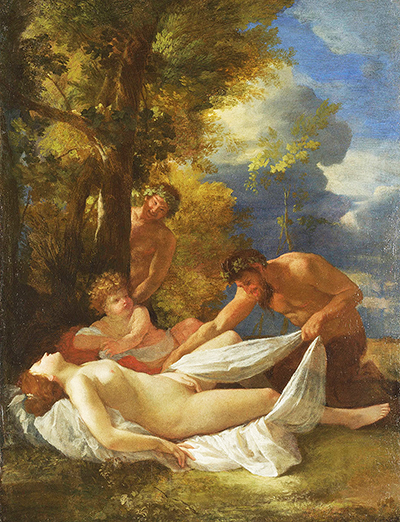Nicolas Poussin's striking painting Nymph with Satyrs (66.4 x 50.3 cm) was painted around 1627. It is one of his earlier pieces, and is an oil painting on canvas.
The subject matter depicts a lovely nymph with smooth curves and pale skin in the foreground, surrounded by an audience of Satyrs. A Satyr in ancient Greek mythology is a creature with the upper body of a man, and the lower body and tail of a goat, and often has pointed ears and goat’s horns. They are lustful and drunken gods that frequent the woods. He smiles lasciviously whilst disrobing her dainty, white robes. She might be asleep or perhaps indulging in some sensual gratification. Peeking out from behind a tree, one glimpses another Satyr who is also smirking salaciously. We also see a child with curly, golden locks lying next to the woman. The background displays beautiful scenery of sky, clouds and trees.
Opinions vary around the theme of the painting. Some say it depicts a story in Roman mythology of Jupiter ravishing the nymph, Antiope. While some believe the nymph could be Venus, the Goddess of Love. Poussin created an earlier version where the child could depict Venus' son, Cupid. His arrow quiver hangs from the tree above him. The scene also presents a pair of white doves, which symbolise lust and are associated with Venus.
In the 17th century, Nicolas Poussin was a leading painter of the classical French Baroque style, but with his unique slant. His work can be described as intellectual, ordered and detached. He was heavily inspired by historical Roman and Greek mythology. He also drew upon influences from Italian artists like Caravaggio and Titian. Poussin and his patrons seemed to pursue the sixteenth-century style of Italian artists who favoured nude, female forms.
Poussin's artwork affected generations of artists to follow. A Sleeping Nymph and Satyr by William Etty, which hangs in the Royal Academy in London, is based on Poussin’s painting. Some other artists influenced by Poussin's work, were the 17th-century artist Sébastien Bourdon, Italian painter Pier Francesco Mola, and Dutch painter Gerard de Lairesse. Neoclassicism pioneers like Joseph-Marie Vien, and his apprentice Jacques-Louis David also advocated his genius. They felt a strong connection to the severity, structure, and logical treatment of his works. Dominique Ingres and Paul Cezanne applied the underlying principles of his classic French painting, but adapted it to relevant issues faced during their artistic era.
Some other similar paintings are Rokeby Venus by Diego Velázquez and The Three Graces by Peter Paul Rubens. Poussin employed unconventional methods while planning his future masterpieces. He utilised a small theater-set or shadow box. He would mold wax figures and place them inside the box in front of a realistic background, and then make sketches while observing the scene. He would theorize and plan every painstaking detail obsessively to create maximum impact. Poussin explored multiple compositions before deciding on which one to paint.




